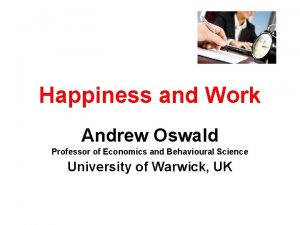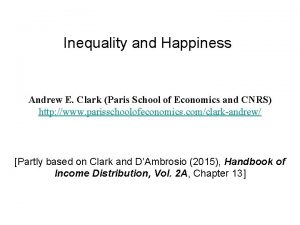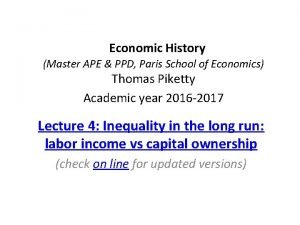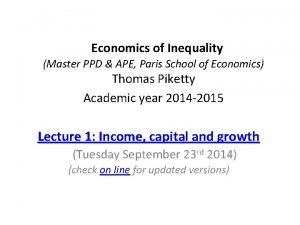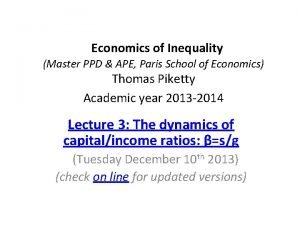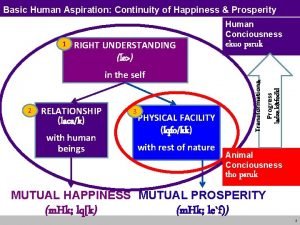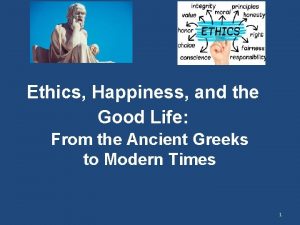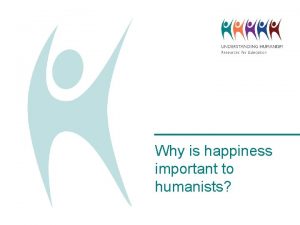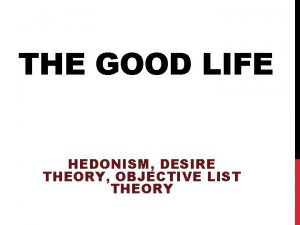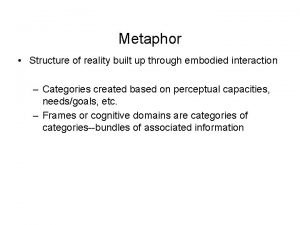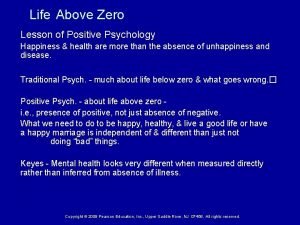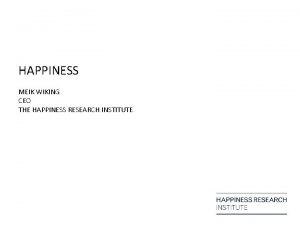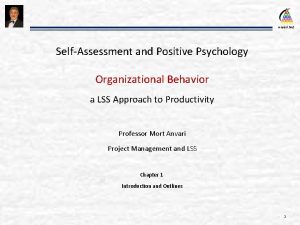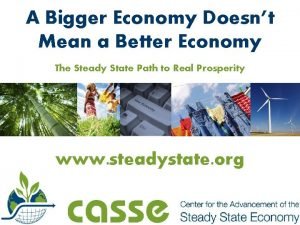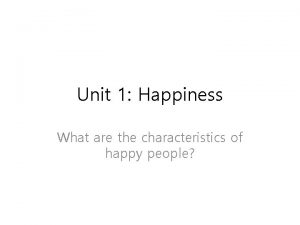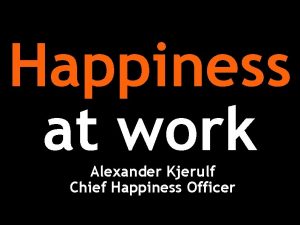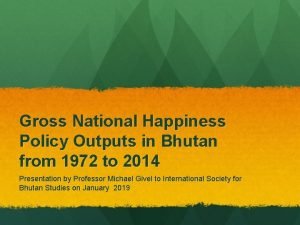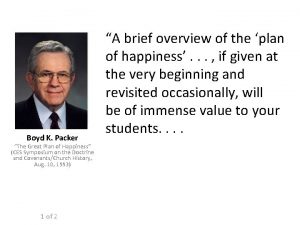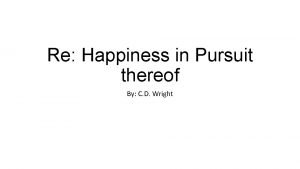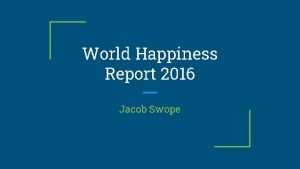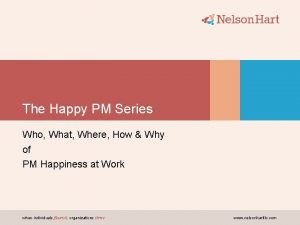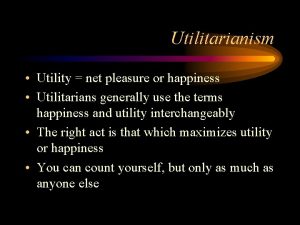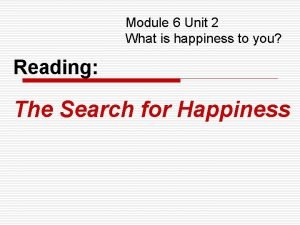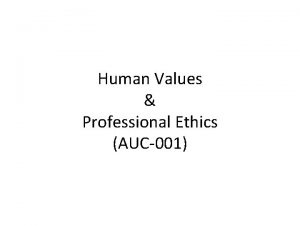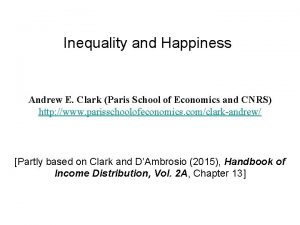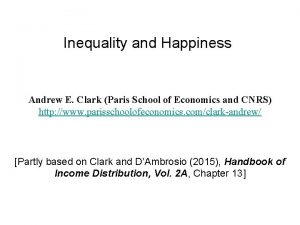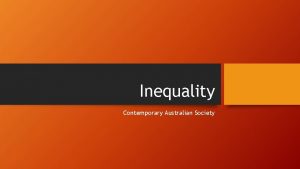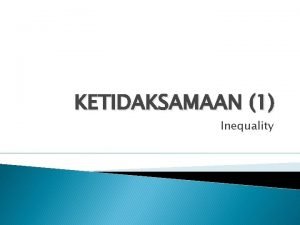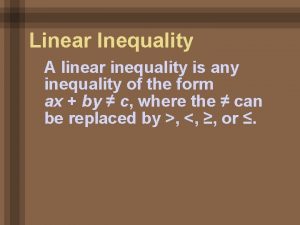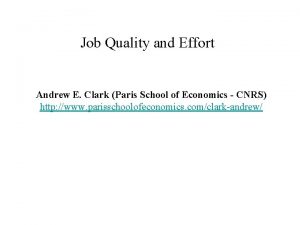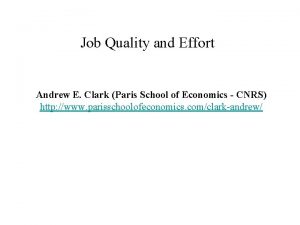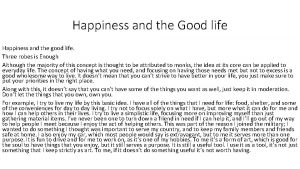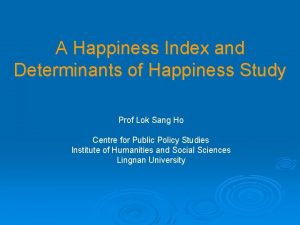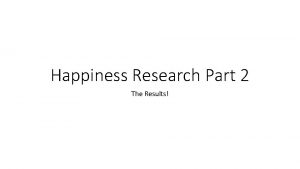Inequality and Happiness Andrew E Clark Paris School











































































- Slides: 75

Inequality and Happiness Andrew E. Clark (Paris School of Economics and CNRS) http: //www. parisschoolofeconomics. com/clark-andrew/ [Partly based on Clark and D’Ambrosio (2015), Handbook of Income Distribution, Vol. 2 A, Chapter 13]

We all like invitations to publish that are based on the MPU. For the Handbook, the original e-mail from Tony and François invited a chapter on “Attitudes to Inequality”: Isn’t it obvious that individuals – including us here now – don’t like inequality? So surely inequality reduces happiness?

And indeed, a very simple model of inequality and happiness produces the same prediction: i) Utility is concave in income ii) Utility is a monotonic input into the social welfare function So greater inequality reduces social welfare. Game over! But can it really be that easy?

We suspect not… Inequality is a social phenomenon: it refers to disparities in incomes between individuals (i. e. there is income inequality when some individuals receive different incomes than do others). The key axiom in the measurement of inequality is the Pigou-Dalton principle of transfers: inequality increases whenever there is a transfer of income from a poorer to a richer individual.

2) We can have a dispassionate normative opinion about any distribution of income, which is independent of our own position in that distribution. In the sense that we’d have the same normative view, wherever we appear in the distribution, or even if we don’t. Can think of this as a “veil of ignorance” evaluation, or a normative opinion about the distribution of income in our own countries in the 19 th century, even though we do not appear in that distribution.

But our gut feeling may well be that there is too much inequality too… Over and above our correct fixation on the diminishing marginal utility of income, we may still conclude that inequality reduces subjective well-being, right? Not finished yet though…

3) Most of the time, we also appear in the income distributions that are changing. So Any change in incomes will affect not only my own income, but also the gaps between my income and the income of others in my society (to whom I compare) – my reference group. This brings about a passionate response, as it were.

Changing income inequality affects not only how much income I receive (my absolute income), but also how much richer and poorer I am compared to others. In this sense, we can think of the utility from income (the indirect utility function), as depending on not only my income but also the income of my reference group: V = V(Yi, ref)

The reference group The term RG was first used by Hyman (1942) in work on the evaluation of the rankings that individuals assign to themselves: it is the group or individuals to whom they compare for the purpose of self-appraisal. The term RG has subsequently been refined numerous contributions across the social sciences, and various definitions of the term are now proposed.

The comparative reference group The comparative RG is in the spirit of the original interpretation by Hyman. The reference group acts as the standard of comparison for self-appraisal: it is the comparison of the individual’s own income to that of others in this reference group that yields status.

Income inequality in the comparative RG Self-appraisal depends on comparisons to those richer and poorer to the individual, and thus to income inequality.

We can further usefully distinguish the comparative reference group according to whether the individual in question is or is not a member of the reference group. When the individual is in the reference group, we typically think that higher income for others reduces my subjective well-being (status). V = V(Yi, ref) + -

When the individual is not (yet) a part of the reference group, but aspires to be, the reference group acts as a relative aspiration, that is as the group of which the individual desires to be a member (signal). V = V(Yi, ref) + + (cf. Hirschman’s tunnel effect).

Let’s take all of this at face value. The correlation between inequality and happiness will be 1) Negative via own income (concavity) 2) Negative (? ) via normative evaluation (but this depends on your views of fairness) 3) Ambiguous via comparisons when you are a RG member, as it depends how Yi changes relative to Yi, ref 4) Ambiguous via comparisons when you are not a RG member, as it depends how Yi changes relative to Yi, ref

The jury really is out. The main culprit so far for this ambiguity is income comparisons: inequality implies changes in both absolute income, and relative income. Life would be so much easier without the latter So how do we know that income comparisons matter for individual happiness?

Happiness approach: Luttmer (2005) US National Survey of Families and Households

Clark (1996). BHPS (UK): very local comparisons Estimated only on couples where both partners are in work. Includes other standard control variables.

Some papers on non-membership. E. g. Senik (2004). RLMS (Russia) A smaller number of recent papers have uncovered empirical results where some measure of individual wellbeing is positively correlated with reference group income or earnings: the more others earn, the more satisfied I am. This finding has been interpreted as demonstrating Hirschman’s tunnel effect (Hirschman and Rothschild, 1973): while others’ good fortune might make me jealous, it may also provide information about my own future prospects.

Some papers on non-membership. E. g. Senik (2004). RLMS (Russia) The distinction between status (-) and signal (+) depends on how likely you are to end up in the future with your reference group’s current income, and thus on mobility between groups.

Subjective Well-Being Measures are not the only possible way of showing comparison effects. 1) The Leyden approach. Invert the question: Who needs more money to have a good life? Initiated by Bernard Van Praag. Ask individuals to assign income levels (per period) to six or nine different verbal labels (such as "excellent“, "sufficient" and "bad").

Van Praag can then estimate for each individual a lognormal “Welfare Function of Income” (the jump in income required to go from one label to another becomes increasingly large). The resulting individual estimated means ( ) and variances ( ) – there is one curve for each person – were then used as dependent variables in regressions to show which types of individuals require a higher level of income to be satisfied, and which individuals have valuations that are more sensitive to changes in income. Those with higher reference group income, and who had earned more in the past, had higher values of .

Those with higher values of μ use lower verbal well-being labels at any given level of income

2) Ask people. Preference for rising income profiles, and preferences for lower absolute incomes: • A: Your current yearly income is $50, 000; others earn $25, 000. • B: Your current yearly income is $100, 000; others earn $200, 000. Individuals have a marked preference for A over B. Positionality differs according to the domain. In Alpizar et al. (2005) this is stronger for cars and housing, and weaker for vacations and insurance.

3) Experimental. a) Ultimatum game: responders frequently rejecting offers that are under 25% of the total sum; as such the vast majority of offers are between 40% and 50% of the sum. b) Dictator game: non-strategic. The survey of 616 such experiments in Engel (2011) concludes that dictators give on average 28. 35% of the sum of money to be divided. This may inform us of normative views of income distributions rather.

c) Zizzo and Oswald (2001) report the results of an experiment whereby subjects can pay to burn each other’s money. A majority of subjects chose to do so, even though it costs them real earnings. The average subject had half of her earnings burnt, and richer subjects were burnt more often. d) Mc. Bride (2010) shows how comparisons to income expectations matter, in a matching pennies game, where individuals play against computers. The computer chooses heads or tails according to (known) probability distributions (for example 80% heads, 20% tails). After each round of playing, individuals report

Introduces social comparisons in some of the treatments (by telling the individual the outcomes of the other players). Income expectation effect identified by varying the heads and tails probabilities played by the computer. Each subject has five pennies to play. When paired with a 80% heads, 20% tails computer, the best strategy is to always play heads, which gives an expected payoff of four pennies. When paired with a 65% heads, 35% tails computer, the best strategy is still to always play heads, but now the expected payoff is only 3. 25 pennies. Results: satisfaction is i) higher the more one wins ii) lower the more others win iii) lower the higher was the aspiration level.

4) Natural Experiments Card et al. (2012): the revelation of information on others' earnings. The natural experiment here is a court decision that made the salary of any California state employee public knowledge. A local newspaper set up a website making it easy to find this information. Following this website launch, Card et al. informed a random subset of employees at three UC campuses about the site.

Some days later, all employees on the three campuses were surveyed. Compare the treatment group (informed about the website) to others to reveal the impact of information on others' salaries. The reference group was defined here as co -workers in the same occupation group (faculty vs. staff) and administrative unit in the university.

The survey found lower job satisfaction for those with pay below the reference group median and a greater intention to look for a new job. The effect on both for those who were relatively well-paid was insignificant. There is some evidence of an actual quitting effect on those who were found to be in the bottom earnings quartile in the reference group.

This is not a banal effect of “low pay leads to lower satisfaction and greater quits”. Pay in the treated and untreated groups is the same. The treated group are instead more likely to find out that they are relatively badly-paid

5) Neuro. Fließbach, K. , Weber, B. , Trautner, P. , Dohmen, T. , Sunde, U. , Elger, C. , & Falk, A. (2007). "Social comparison affects reward-related brain activity in the human ventral striatum". Science, 318, 1305 -1308.

Payoffs vary according to whether the individual gets the task right, and also randomly when the task is correct

Brain activity measured via BOLD blood flow in various voxels. Particular attention paid to the ventral striatum: the “neural circuitry of reward” This kind of striatal activity has been shown to predict both hedonic outcomes (subjective well -being) and physiological outcomes (cortisol output: the body’s response to stress)

Brain activation depends on relative income: compare C 6, C 8 and C 11 (where the individual receives 60 Euros), and C 7 to C 9.

The normative approach Evaluation of the overall degree of income inequality in the reference group, without making any comparisons to others.

Experimental attitudes to inequality The experimental economics contributions to inequality aversion from the more aggregate perspective have appealed to two different approaches: 1) inequality and risk aversion with a parametric social welfare function; 2) general social welfare functions.

Experimental attitudes to inequality 1) In inequality and risk aversion with a parametric social welfare function two types of experiments have been run. The first is similar to that adopted in the experiments on status or relative income that is the choice between alternative societies with different income distributions behind the veil of ignorance (the “hypothetical grandchild”). The second is based on the leaky-bucket experiment.

Experiment type 1: The well-being of imaginary grandchilden in alternative societies which are characterized by different uniform income distributions (e. g. , Society A ranges from 10, 000 to 50, 000 Swedish kroner, but Society B from 19, 400 to 38, 800 Swedish kroner). Expected income higher in Society A Choose the society that is best for your grandchild. Respondents were also told that they did not know their grandchild’s position in the income distribution, and that they should place equal probability on all outcomes.

The more inequality-averse the individual is, the more they are willing to trade-off expected income in order to achieve a more equal income distribution. Individuals do exhibit a considerable amount of inequality aversion in these experiments

Amiel, Creedy, Hurn (1999) belongs to the second type of experiment type 1, in which social inequality aversion is estimated via the leaky-bucket experiment. A sample of students were asked to indicate the amount of ‘lost money’ that they were willing to accept for a transfer of money from a richer to a poorer individual, loss due to administrative costs. The median value of inequality aversion was much lower than the existing estimates from hypothetical grandchildren. However, the circumstances of the two experiments are very different, making a clear comparison of the results rather difficult.

2) general social welfare functions. In the income-distribution literature the indices that are deemed appropriate to measure inequality are those which conform to the Lorenz dominance criterion. These indices fulfill four basic axioms: scale invariance, symmetry, the population principle and the Pigou-Dalton transfer principle. The first three properties are commonly assumed in the majority of indices of well-being; only the principle of transfers is at the heart of inequality measurement. Attitudes towards inequality have been interpreted by some authors as the reaction of the general public to these four basic properties.

The seminal book is this area is Amiel and Cowell (1999). Given that the defining concept for inequality measurement is the Pigou-Dalton transfer principle, we discuss only those experimental results which cover this aspect of inequality. Verbal experiment: “Suppose we transfer income from a person who has more income to a person who has less, without changing anyone else’s income. After the transfer the person who formerly has more still has more. ” 60% agree that this reduces inequality.

Numerical experiment: Consider two income distributions: Society A = (l, 4, 7, 10, 13) Society B = (l, 5, 6, 10, 13). Only 1/3 agree that Society B is more equal than Society A (even though the “transfer” between the two corresponds to the Pigou-Dalton principle, and to the previous verbal experiment) Individuals think of falling income inequality in Robin Hood terms (and perhaps also of rising inequality in Sheriff of Nottingham terms)

What is then the sum total of own income, income comparisons, tunnel effects and the normative evidence? Inequality and well-being There are many equations estimated such as:

Ineq here is almost always Gini. Table 1 in our chapter provides a representative sample of estimation results for γ above. There are 27 rows: • In 14 γ is < 0 • In 5 it is > 0 • In 6 it is = 0 • In one we don’t know • And in the last, it is both positive and negative. Probably fair to say that this is inconclusive (and beware of the Moulton correction!).

Note 1 Is the Gini the “best” measure of the distribution for the normative evaluation? Gini moves relatively little over time, making multicollinearity a distinct possibility in cross -country work. Others are possible, such as the income share of the top quintile, D 9/D 1, p 95/p 50, the percentage in poverty, or even rank in the income distribution. Ebert and Welsch (2009) is relatively unusual in comparing the fit of different distribution measures, in explaining life satisfaction, and concluding that “the overall degree of inequality aversion is larger than that implied by the standard measures applied in empirical analysis” Most applied work doesn’t compare distribution measures

Note 2 Fairness and perceptions. Above measures of income are objective: they measure what others in the society actually earn. This is of course not necessarily what individuals believe that others earn. ISSP question: "We would like to know what you think people in these jobs actually earn. Please write in how much you think they usually earn each year, before taxes. (Many people are not exactly sure about this, but your best guess will be close enough. This may be difficult, but it is important, so please try. ). First, about how much do you think a bricklayer earns? "

And then: what these individuals should earn each year before taxes, regardless of what they do actually receive. Asked for a bricklayer, Doctor in general practice, bank clerk, an owner of a small shop, the chairman of a large national company, a skilled worker in a factory, a farm worker, a secretary, a city bus driver, an unskilled factory worker, and a cabinet minister in a national government. Can use these to create a subjective (individuallevel) measure of the fairness of the income distribution. Take top and bottom occupations: Legitimate Inequality = ln[(PIMD/PIunskilled)/(JIMD/JIunskilled)]

Legitimate inequality > 0 for those who believe income gaps should be smaller. For example, Schneider finds an average value of the first term in the square brackets of around 644, and the average value of JIMD/JIunskilled just over 300. This yields a value of legitimate inequality of around 0. 75. LI is negatively correlated with life satisfaction. Osberg and Smeeding (2006) use the entire set of individual responses to calculate the perceived and just Gini. Most people are in favour of some levelling of incomes, while almost no-one believes that all incomes should be the same. On average, the ratio of the Gini coefficients is 0. 75. In some countries, such as the US and Japan, this figure is around 0. 8, in others such as Spain and Sweden it is under 0. 7.

Perceptions of the fairness of the income distribution affect the relationship between income inequality and life satisfaction. They also affect behaviour in the lab (decisions depend on whether income is earned or allocated). The “manna from heaven” aspect of much of income in laboratory experiments may make them less good predictors of behaviour in the real world, where income is earned.

How good is your perception of your home country’s income distribution? The OECD's new web-tool Compare your income allows you to see whether your perception is in line with reality. In only a few clicks, you can see where you fit in your country's income distribution. http: //www. oecd. org/statistics/compare-yourincome. htm [Not telling you how well I did]

Note 3. Preferences for redistribution If we want to know about individuals’ attitudes regarding income inequality, why don’t we just ask them if they want less of it? Key predictions here regarding individuals’ positions in the income distribution, both now and what they expect in the future (POUM). Empirically, both current income and predicted or experienced mobility do predict the individual’s desire to redistribute income. Alesina et al. (2004) show that the effect of inequality on happiness is larger in value in Europe than in the USA: because of greater perceived social mobility in the USA than in Europe

Fairness plays a role here too. Those who believe that income is due to hard work (or that the poor are lazy) are less willing to redistribute. And the actual level of inequality does increase the desire to redistribute.

Note 4. To whom do we compare? Almost all of the survey literature assumes that everyone compares to everyone. In the experimental literature, which can manipulate such things, comparisons to people richer than you matter more than comparisons to those poorer than you. And it is unlikely that we all compare to the whole income distribution, making the overall well-being effects of any change in the income distribution even harder to predict.

Altruism In addition, we may be compassionate about some people in our reference group. So we are happy when they become better off. See the work of Elizabeth Dunn on altruism, and the literature on charitable giving.

Note 5. Other outcome measures. We have looked at SWB and the desire to redistribute. Other intriguing work has highlighted significant empirical correlations between (almost always) the Gini coefficient and: • Agreeableness (Big Five): -

Note 5. Other outcome measures. We have looked at SWB and the desire to redistribute. Other intriguing work has highlighted significant empirical correlations between (almost always) the Gini coefficient and: • Agreeableness (Big Five): • Trust: -

Note 5. Other outcome measures. We have looked at SWB and the desire to redistribute. Other intriguing work has highlighted significant empirical correlations between (almost always) the Gini coefficient and: • Agreeableness (Big Five): • Trust: • Political Participation: -

Note 5. Other outcome measures. We have looked at SWB and the desire to redistribute. Other intriguing work has highlighted significant empirical correlations between (almost always) the Gini coefficient and: • • Agreeableness (Big Five): Trust: Political Participation: Support for globalisation: -

Note 5. Other outcome measures. We have looked at SWB and the desire to redistribute. Other intriguing work has highlighted significant empirical correlations between (almost always) the Gini coefficient and: • • • Agreeableness (Big Five): Trust: Political Participation: Support for globalisation: Violent behaviour: +

Note 5. Other outcome measures. We have looked at SWB and the desire to redistribute. Other intriguing work has highlighted significant empirical correlations between (almost always) the Gini coefficient and: • • • Agreeableness (Big Five): Trust: Political Participation: Support for globalisation: Violent behaviour: Self-enhancement: + +

Note 5. Other outcome measures. We have looked at SWB and the desire to redistribute. Other intriguing work has highlighted significant empirical correlations between (almost always) the Gini coefficient and: • • Agreeableness (Big Five): Trust: Political Participation: Support for globalisation: Violent behaviour: Self-enhancement: Female Preferences for facial masculinity: + + +

Note 6. Causality? Let’s just say that this has been treated in a pretty cavalier fashion in this literature. Changes in income happen for a reason: could be that it is this reason that affects well-being, not income inequality as such. Or that happiness causes inequality, rather than inequality causing happiness. So all we need is an exogenous movement in the income distribution…

If only… There is some interesting work that has appealed to movements in the minimum wage. Support for minimum-wage rises highest amongst minimum wage workers. And lowest amongst those who earn just above the minimum wage (last-place aversion). In unpublished work on the SOEP we find negative correlation between life satisfaction and minimum wage rises in Germany that is the largest for those earning just over the minimum wage.

Note 7. And finally… We don’t really care about income Income is only instrumental: we like income because it makes us happy/brings us utility. Rather than looking about income inequality, what about happiness inequality? Economic growth reduces the inequality of subjective well-being

Between countries

And within countries

This is (we think) a nice complement to the Easterlin Paradox, where income growth at the country level doesn’t seem to be correlated with average happiness in that country. Here are some examples:

United Kingdom (BHPS): Real GDP per capita and life satisfaction 1996 - 2008

West Germany (SOEP): Real GDP per capita and life satisfaction 1984 - 2010

Australia (HILDA): Real GDP per capita and life satisfaction 2001 - 2009

Life Satisfaction in Five European Countries, (World Database of Happiness) 1973 -2004

Happiness in 30 years of GSS data

We think that higher income reduces the dispersion of well-being through the provision of public goods (paid for by the rich, enjoyed by all) Happiness inequality is determined by income inequality as well. Modern growth has come with greater income inequality. In most countries the level of income effect has trumped the income inequality effect. One exception: the US post-around 1990:

GSS Data
 Clark and clark marketing functions
Clark and clark marketing functions Andrew oswald happiness
Andrew oswald happiness 1-6 solving compound and absolute value inequalities
1-6 solving compound and absolute value inequalities Andrew clark el club de los cinco
Andrew clark el club de los cinco Andrew e clark
Andrew e clark School trip to paris
School trip to paris Paris school of economics ape
Paris school of economics ape Master ppd
Master ppd Paris school of economics ape
Paris school of economics ape Virtue ethics revision
Virtue ethics revision It comprises happiness sadness anger and fear
It comprises happiness sadness anger and fear Chinese symbol for health, wealth and happiness
Chinese symbol for health, wealth and happiness Describe basic human aspirations
Describe basic human aspirations Nothing is more precious than happiness and health.
Nothing is more precious than happiness and health. I aspire for happiness and prosperity in continuity
I aspire for happiness and prosperity in continuity Laden with happiness and tears
Laden with happiness and tears Ethics happiness and the good life
Ethics happiness and the good life Lewis and clark and me spelling words
Lewis and clark and me spelling words What was the purpose of the sibley commission
What was the purpose of the sibley commission Humanism happiness
Humanism happiness Pleasure vs happiness
Pleasure vs happiness The good life
The good life Candy named after indian burial grounds
Candy named after indian burial grounds Deploy happiness
Deploy happiness Happy morpheme
Happy morpheme Metaphor examples sad
Metaphor examples sad Life above zero short note
Life above zero short note Hedonism and utilitarianism
Hedonism and utilitarianism Principle of happiness
Principle of happiness Nash popovic
Nash popovic Ceo of happiness
Ceo of happiness Metaphor in happy song
Metaphor in happy song Emotional hierarchy
Emotional hierarchy Emotional intelligence happiness
Emotional intelligence happiness Happiness lyrics charlie brown
Happiness lyrics charlie brown Happiness with contentment is great gain
Happiness with contentment is great gain Happiness definition psychology
Happiness definition psychology Inglehart
Inglehart Four pillars of gross national happiness
Four pillars of gross national happiness Unit 1 happiness
Unit 1 happiness Chief happiness officer portugal
Chief happiness officer portugal Four pillars of gross national happiness
Four pillars of gross national happiness Happiness drama
Happiness drama Example of expressing happiness
Example of expressing happiness Great plan of happiness
Great plan of happiness Www.authentichappiness.org
Www.authentichappiness.org Aristotle about happiness
Aristotle about happiness What of this goldfish would you wish vocabulary
What of this goldfish would you wish vocabulary Happy raj
Happy raj Hymns about happiness
Hymns about happiness Walt whitman happiness not in another place
Walt whitman happiness not in another place Estoy happy
Estoy happy Unit 1 happiness
Unit 1 happiness Pursuit of happiness poem
Pursuit of happiness poem Adjective joy
Adjective joy Happiness is sister
Happiness is sister Kaggle world happiness report
Kaggle world happiness report The joy of serving god
The joy of serving god Happiness at work
Happiness at work The greatest happiness is to scatter your enemy
The greatest happiness is to scatter your enemy Happiness
Happiness What factors contribute to happiness
What factors contribute to happiness Daily happiness checklist
Daily happiness checklist Who global action plan
Who global action plan Aristotle ethics happiness
Aristotle ethics happiness Act utilitarianism definition
Act utilitarianism definition In aquinas view man's ultimate happiness consists in
In aquinas view man's ultimate happiness consists in 6 steps to happiness
6 steps to happiness Without sadness there is no happiness
Without sadness there is no happiness Hold thy desperate hand art thou a man
Hold thy desperate hand art thou a man Plato republic happiness
Plato republic happiness Unit 1 happiness
Unit 1 happiness Duty is superior to happiness example
Duty is superior to happiness example Duty is superior to happiness example
Duty is superior to happiness example Marriage doesn't guarantee happiness
Marriage doesn't guarantee happiness Natural acceptance
Natural acceptance

